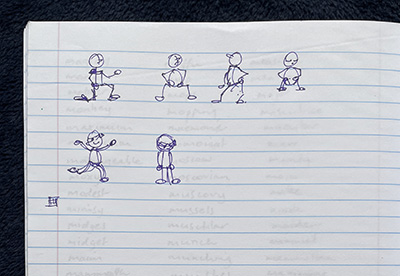
Cartoon references — perhaps you relate to this question I received recently:
“How do I reduce my reliance on references for cartooning?”
(I’m not, even for a single second, knocking copying or the use of cartoon references. I use them, you use them, and more importantly, every cartoonist since the Year Dot has used references. There’s no doubt that they work.
But do we always need cartoon references?)
Let’s think for a moment …
Why do we use cartoon references in the first place?
- we have an idea for a cartoon but
- we don’t know quite how to do it, so
- we go hunting for reference material.
But maybe we do have the memories 🧐?
If you dig a bit, using a method that doesn’t put you under too much mental pressure, I think you’ll surprise yourself.
A pressure-free exercise from the World of Words
I know a teacher who starts a writing session by creating a simple list. You choose a letter of the alphabet and spend 3-5 minutes recording every word you can think of that starts with (say) “R”.
The value of the exercise is seeing how you get to the words. Initially, they might just come. Sometimes you end up systematically working through different versions of the same word: right, rights, righted, rightly. You might end up trying all the vowels as the second letter, or seeing which consonants are possible in a process of elimination. And other times a word just appears out of nowhere, unrelated to any word so far.
The point is that sometimes words simply arrive, sometimes you really trawl your memory, sometimes you look around the room, sometimes you work them out systematically… all are valid ways of ‘finding R words’.
This is useful for digging up and growing your pose memories
Translating this practice into cartooning terms, spend 3-5 minutes just drawing stick-figure poses — as many as you can, for the time on the clock. Yes, go for five minutes, because three minutes is too little when drawing.
You will end up with all sorts of body shapes and limb positions; some will be absolute mishaps. Similarly to the word-finding exercise, sometimes you will ‘see’ a pose with ease, sometimes you will consciously experiment, sometimes you willmis-step and then work out what to do to fix it.
You could add a a constraint and deeper focus by choosing just one category of pose. Standing poses is a good challenge — there are so many ways to stand, believe it or not! Leaning poses, sitting poses, thinking poses, talking poses… you get the idea.
Regardless, it’s a good way to break the curse of the blank page.
And it has other benefits, too
- you end up with a ton of poses that spark ideas in your imagination
- you realise that your brain contains more memories than you thought
- it grows your confidence because you work things out
